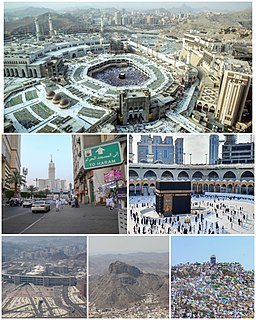
Mecca, officially Makkah al-Mukarramah and commonly shortened to Makkah, is a city and administrative center of the Mecca Province of Saudi Arabia, and the holiest city in Islam. It is 70 km (43 mi) inland from Jeddah on the Red Sea, in a narrow valley 277 m (909 ft) above sea level. Its last recorded population was 1,578,722 in 2015. Its estimated metro population in 2020 is 2.042 million, making it the third-most populated city in Saudi Arabia after Riyadh and Jeddah. Pilgrims more than triple this number every year during the Ḥajj pilgrimage, observed in the twelfth Hijri month of Dhūl-Ḥijjah.

An umbrella or parasol is a folding canopy supported by wooden or metal ribs that is usually mounted on a wooden, metal, or plastic pole. It is designed to protect a person against rain or sunlight. The term umbrella is traditionally used when protecting oneself from rain, with parasol used when protecting oneself from sunlight, though the terms continue to be used interchangeably. Often the difference is the material used for the canopy; some parasols are not waterproof, and some umbrellas are transparent. Umbrella canopies may be made of fabric or flexible plastic. There are also combinations of parasol and umbrella that are called en-tout-cas.
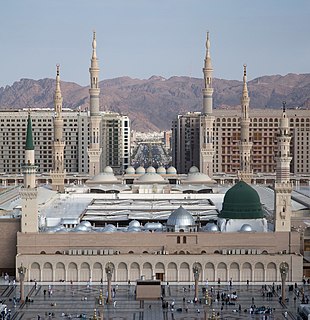
Al-Masjid an-Nabawi, known in English as The Prophet's Mosque, is a mosque built by the Islamic prophet Muhammad in the city of Medina in the Al Madinah Province of Saudi Arabia. It was the second mosque built by Muhammad in Medina, after Masjid Quba', and is the second largest mosque and second holiest site in Islam, both titles ranking after the Masjid al-Haram in Mecca. It is generally open regardless of date or time, and has only been closed to visitors once in modern times, as Ramadan approached during the 2020 COVID-19 pandemic.
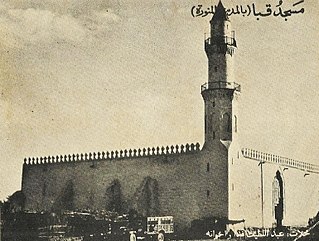
The Quba Mosque is a mosque located on the outskirts of Medina, Saudi Arabia. Initially, the mosque was built 6 kilometres off Medina in the village of Quba, before Medina expanded to include this village. Depending on whether the Mosque of the Companions in the Eritrean city of Massawa is older or not, it may be the first mosque in the world that dates to the lifetime of the Islamic prophet Muhammad in the 7th century CE. According to records, its first stones were positioned by Muhammad as soon as he arrived on his emigration from the city of Mecca to Medina, and the mosque was completed by his companions. Muhammad spent 14 days in this mosque praying qaṣr while waiting for Ali to arrive in Medina, after the latter stayed behind in Mecca to safeguard Muhammad’s life and safe escape by sleeping in Muhammad’s bed in his place, an event referred to in the Quran, sura al Baqara verse 207. Also going along with traditional saying, this mosque is said to be where the first Friday prayer was held, led by Muhammad.

Expo 2000 was a World Expo held in Hanover, Germany from Thursday 1 June to Tuesday 31 October 2000. It was located on the Hanover Fairground, which is the largest exhibition ground in the world. Initially some 40 million people were expected to attend the exhibition over the course of months; however, eventually with less than half of this number, the Expo was a flop and turned out to be a financial failure.

Egon Eiermann was one of Germany's most prominent architects in the second half of the 20th century.
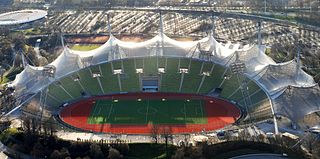
Olympiastadion München is a stadium located in Munich, Germany. Situated at the heart of the Olympiapark München in northern Munich, the stadium was built as the main venue for the 1972 Summer Olympics.

A tensile structure is a construction of elements carrying only tension and no compression or bending. The term tensile should not be confused with tensegrity, which is a structural form with both tension and compression elements. Tensile structures are the most common type of thin-shell structures.
Frei Paul Otto was a German architect and structural engineer noted for his use of lightweight structures, in particular tensile and membrane structures, including the roof of the Olympic Stadium in Munich for the 1972 Summer Olympics.
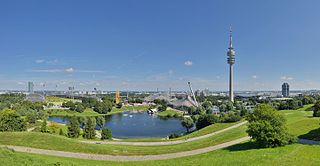
The Olympiapark in Munich, Germany, is an Olympic Park which was constructed for the 1972 Summer Olympics. Located in the Oberwiesenfeld neighborhood of Munich, the Park continues to serve as a venue for cultural, social, and religious events, such as events of worship. It includes a contemporary carillon. The Park is administered by Olympiapark München GmbH, a holding company fully owned by the state capital of Munich.

The Abraj Al-Bait is a government-owned complex of seven skyscraper hotels in Mecca, Saudi Arabia. These towers are a part of the King Abdulaziz Endowment Project that aims to modernize the city in catering to its pilgrims. The central hotel tower, the Makkah Clock Royal Tower, has the world's largest clock face and is the third-tallest building and fifth-tallest freestanding structure in the world. The clock tower contains the Clock Tower Museum that occupies the top four floors of the tower.

Po-i-Kalan, or Poi Kalan, is an Islamic religious complex located in Bukhara, Uzbekistan. The complex consists of three parts, the Kalan Mosque, the Kalan Minaret to which the name refers to, and the Mir-i-Arab Madrasah. The positioning of the three structures creates a square courtyard in its center, with the Mir-i-Arab and the Kalan Mosque standing on opposite ends. In addition, the square is enclosed by a bazaar and a set of baths connected to the Minaret on the northern and southern ends respectively.

Werner Sobek is a German architect and structural engineer.
Buro Happold is a British professional services firm that provides engineering consultancy, design, planning, project management, and consulting services for buildings, infrastructure, and the environment. It was founded in Bath, Somerset, in 1976 by Sir Edmund Happold when he took up a post at the University of Bath as Professor of Architecture and Engineering Design.
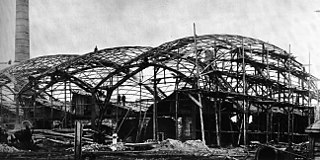
A gridshell is a structure which derives its strength from its double curvature, but is constructed of a grid or lattice.
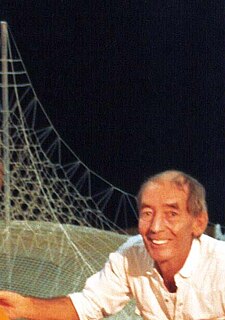
Conrad Roland was a German architect and pioneer of the construction of spacenets, which primarily are to be found as rope climbing frames on playgrounds. In 1978 he designed and constructed the biggest spacenet of the world until today, the Super Four Mast Spacenet, for the Federal Horticultural Show (BUGA).
The SL Rasch GmbH Special and Lightweight Structures, based in Stuttgart, Germany, specializes in special and lightweight structures integrating architecture and engineering. The company was founded by Mahmoud Bodo Rasch. Among the most famous projects are the large retractable umbrellas in front of the Mosque of the Prophet in Medina and the Makkah Clock Tower, the tallest clock tower in the world.

Masjid al-Haram, also known as the Great Mosque of Mecca, is a mosque that surrounds the Kaaba in Mecca, in the Mecca Province of Saudi Arabia. It is a site of pilgrimage in the Hajj, which every Muslim must do at least once in their lives if able, and is also the main phase for the ʿUmrah, the lesser pilgrimage that can be undertaken any time of the year. The rites of both pilgrimages include circumambulating the Kaaba within the mosque. The Great Mosque includes other important significant sites, including the Black Stone, the Zamzam Well, Maqam Ibrahim, and the hills of Safa and Marwa.
Allmann Sattler Wappner Architekten is a German architecture firm based in Munich. Established in 1987, it has existed in its current form since 1993. In 1997, Allmann Sattler Wappner Architekten received the German Architecture Award. Among many other buildings they had designed the Dornier Museum in Friedrichshafen, the Herz Jesu Church and the Haus der Gegenwart in Munich. According to the firm they currently employ 100 members of staff.

Medina Haram Piazza Shading Umbrellas or Al-Masjid An-Nabawi Umbrellas are convertible umbrellas erected at the piazza of Al-Masjid an-Nabawi in Medina, Saudi Arabia. The shade of the umbrella is spread in the four corners, and the area covered by the shade extends to 143,000 square meters. These umbrellas are aimed to protect worshipers from the heat of the sun during prayer, as well as from the risk of slipping and falling in the event of rain. Similar structures are built at the square of the mosques worldwide. At Al-Masjid An-Nabawi, there are total of 250 umbrellas.















